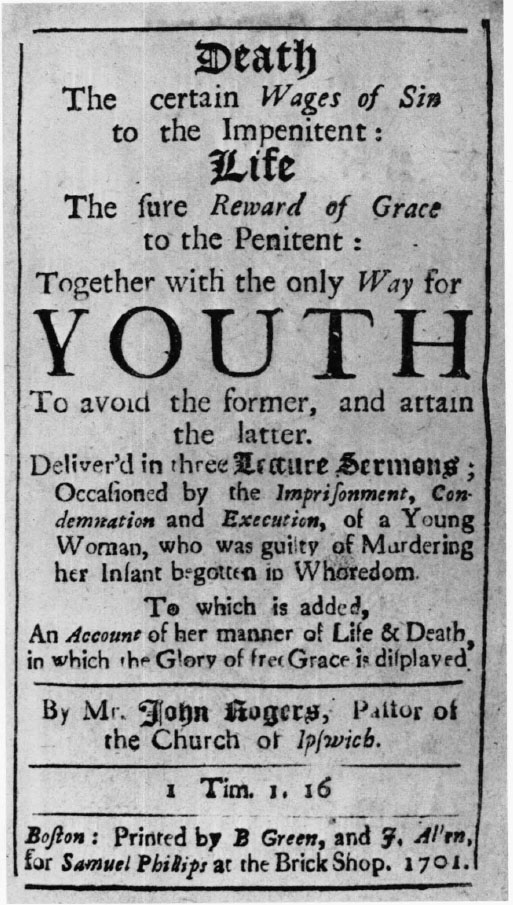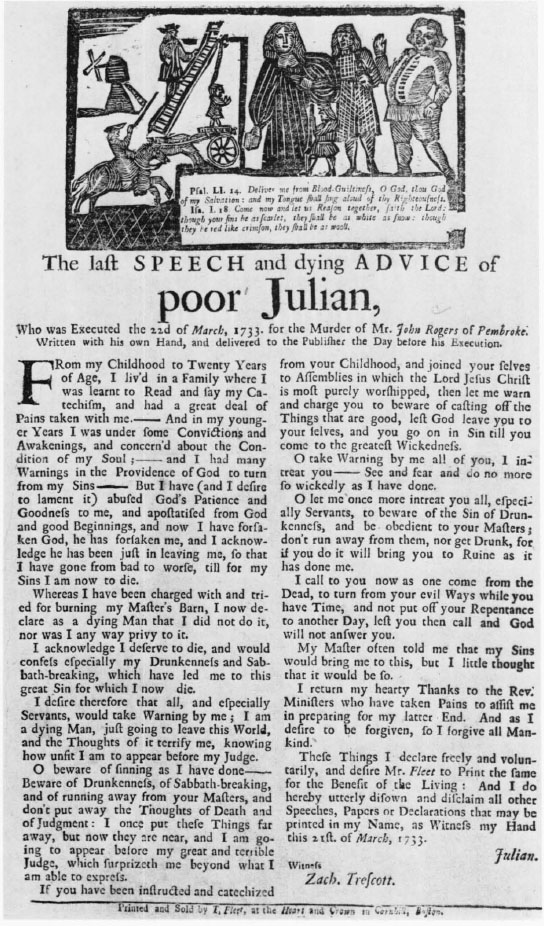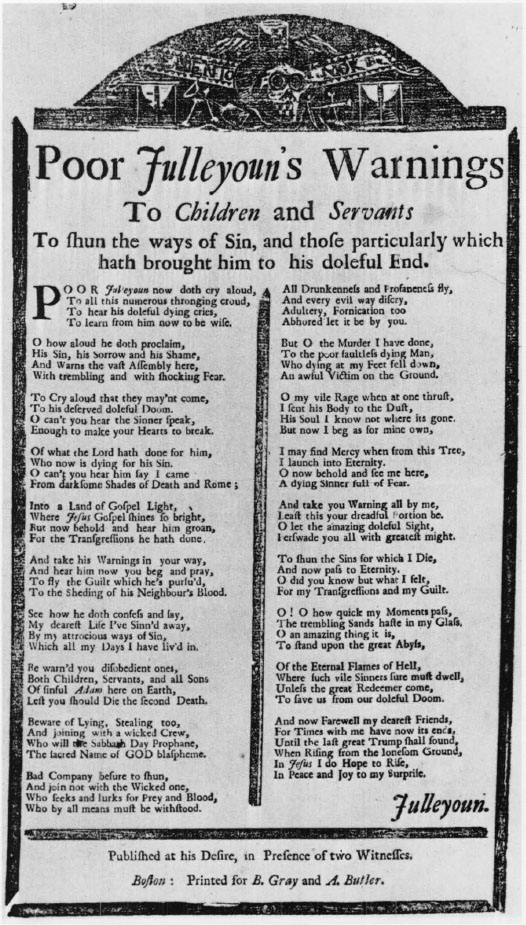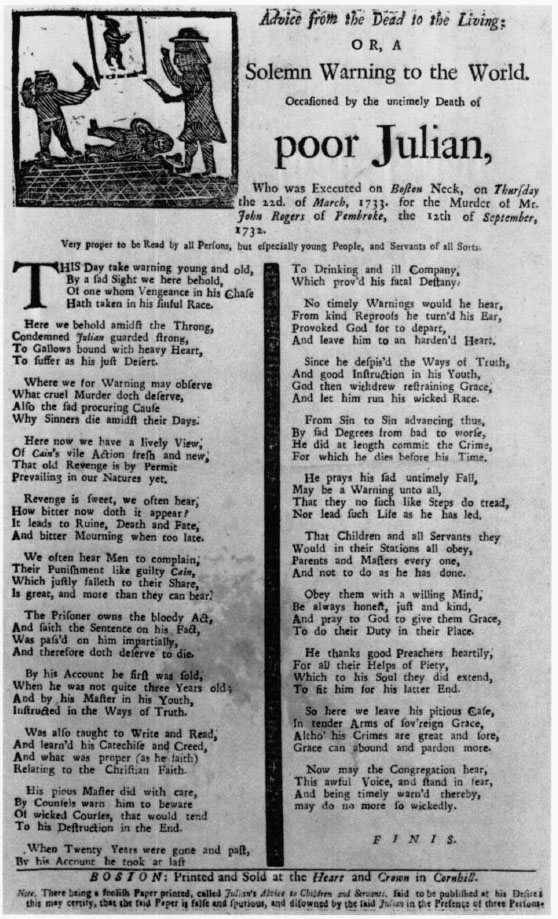True Confessions and Dying Warnings in Colonial New England
By Lawrence W. Towner*
I
LATE in July 1701, Esther Rodgers of Ipswich, Massachusetts, died on the gallows. “The manner of her Entertaining DEATH,” said the account published that year by the Reverend Mr. John Rogers, was “astonishing to a Multitude of Spectators,” who numbered some four to five thousand souls. Her “Composure of Spirit, Cheerfulness of Countenance, pleasantness of Speech, and a sort of Complaisantness in Carriage towards the Ministers who were assistant to her, . . . melted the hearts of all that were within seeing or hearing, into Tears of affection. . . .”1
Poor Esther had been born in Kittery sometime in May of 1680. At thirteen, she was apprenticed in Newbury, where she was taught to read and required to learn John Cotton’s catechism. She forgot it, however, for at the age of seventeen she found herself pregnant by “a Negro Lad living in the same House.”2 Remarkable as it may seem, she delivered the baby herself without anyone suspecting her condition and immediately buried the child, after suffocating it, in her master’s garden.
Esther came out of her apprenticeship at eighteen and worked in a public house in Piscataqua, returning within a year to her former master, only to leave him again, for a position in Ipswich. There she again strayed from the narrow way, and again became pregnant by a black servant. This child she delivered in a field and again immediately did away with it. Her crime was soon discovered, however, and the court convicted her of murder. Some eight months later, she was turned off into eternity.
The Reverend Mr. Rogers’ account of Esther’s life is entitled Death The certain Wages of Sin to the Impenitent: Life The sure Reward of Grace to the Penitent: Together with the only Way for YOUTH To avoid the former, and attain the latter. It comprises an introduction by the Reverend Mr. William Hubbard, three lecture-day sermons by John Rogers, and—from Esther—a detailed confession, an account of her experiences in jail, two statements, a final dying warning, and a last prayer; altogether 154 pages. This, in short, is the classic True Confession and Dying Warning.
In these pages we see the grand design of sin, remorse, confession, presumptive salvation, and death. Esther had been introduced to religion at an early age, but in sabbath-breaking and evil-company-keeping she had run afoul not only of God’s law but of man’s. She hid from man her first infanticide; but in typical Puritan fashion, God’s punishment confirmed her in the very same crime. Sin begot sin. In jail her hardened heart rejected the words of the visiting ministers—including the famous Mr. John Wise—and “other Christians of the Town and Neighbourhood.”3 Ultimately, however, through the good offices of an “Ambassador of Jesus Christ”—presumably our author—she repented, confessed, and threw herself on the Lord’s mercy. She “approved the Verdict and Sentence, that they were just and right.”4 In church, shortly before her execution, she was told that she was a “Dead Woman; not only that she was dead in Trespasses & Sins, but . . . in Law, and by a Sentence of Condemnation must be put to Death before another Sabbath come about. . . .” And yet, argued the Reverend Mr. Rogers, “there is more than a possibility through Grace, that she may Live again; though not in this World. . . .”5
On the scaffold, Esther’s last words were taken down in shorthand. She would die a shameful death, she said, and a justly deserved one. From it, let all young people take warning: “I beg of all to have a Care. Be Obedient to your Parents and Masters; Run not out at Nights, especially on Sabbath Nights, Refrain bad Company for the Lord’s Sake. . . . Keep God’s Sabbaths, mind the Word of God, and let good People be your Company. . . .”6
Finally, the account concludes, “being bid to lean her Head back upon the Ladder, to receive the Halter, She readily does it; and Cryes, . . . O Come Lord Jesus by Thy Pardoning Mercy, to Save me Now, or I perish for ever. My Blessed Jesus, O Lord Jesus, have Pity upon me, O Good Lord . . .”7
II
As it was with so many aspects of New-England culture, the literature of True Confessions and Dying Warnings had its antecedents in old England. As the late Clifford K. Shipton first pointed out many years ago, in gentle opposition to the Turner thesis, what may have been notable about colonial New England was not so much the influence of the frontier in shaping its institutions, but rather the degree to which the colonists were able to reproduce on the frontier what they had known in old England.8
The precedent for True Confessions and Dying Warnings can be traced at least as far back as the distinguished Puritan divine, William Perkins, whose name is referred to several times in the works we are about to examine. As late as 1713, for example, Cotton Mather wrote of “the famous Mr. Perkins . . . who dealt much with Condemned Prisoners. . . .”9 A check on the writings of this Puritan forerunner, the father of so many ideas carried to New England, reveals no titles that sound like True Confessions and Dying Warnings, but he had been concerned with prisoners in old Cambridge and often accompanied them to their executions.1
Execution sermons and confessions were quite common in England in the sixteenth and seventeenth centuries.2 By the eighteenth, they had become a staple crop in John Applebee’s London Weekly Journal. “Mr. Applebee,” wrote Eustace Budgell, a contemporary, “takes Care to purchase from all our dying Criminals the private Memoirs of their Lives and Conversations; and though many of these pieces have been wrote or dictated under great Perturbation of Mind, and consequently have not been very Coherant, they still incite the Curious and Inquisitive to peruse Mr. Applebee’s Journal.”3
True Confessions and Dying Warnings found a rich and ready soil in the lives of New-England Puritans, where confession already flourished. That phenomenon appears as early as the pre-migration writings of the greatest Puritan of them all, John Winthrop. It was only after the most rigorous examination of his evil ways that Winthrop could find relief from the nagging suspicion that he was damned; that, on taking his spiritual temperature, he could believe he was not running a fever after all. These confessions, confided to paper in his “Christian Experienca,”4 were private of course, as were those much later that can be read only with agony in the diaries of such worthies as Michael Wigglesworth and Cotton Mather.5
In Mather’s Diary, confessions begin on 16 April 1681, his nineteenth year, and carry on for two volumes, almost without relief. There are some 250 there, and the most vivid image one gains is of his groveling on the floor of his study confessing unworthiness and begging forgiveness. He wrote on 7 February 1707: “I sett apart this Day, to humble myself deeply before the Lord, for my horrible Corruptions and Miscarriages. I could plainly discern on myself, grevious Marks of a Man abhorred of the Lord. And as one even ashamed to approach unto Heaven, I lay prostrate in the Dust afar off, crying out, God be merciful to me a Sinner.”6 As David Stannard has emphasized in his “Death and Dying in Colonial New England,” “The best sign . . . [of salvation] . . . was to be unsure.”7 By admitting his wickedness, Mather was assuring himself he was unsure of assurance and therefore more than likely still among the assured!
Private confession before God alone, however, was only one aspect of its role in the Puritan’s religious life. Public confession in church, not only of one’s faith (and an examination thereof by the elect) was a commonplace occurrence. To a good Puritan, this was deadly serious business, as is revealed in the Reverend Mr. John Fiske’s Notebook of the transactions of the church at Wenham, Massachusetts, in the early seventeenth century.8
True, later in the century, these confessions of faith became more nominal, or are at least recorded more perfunctorily. Thus, at the First Church of Beverly, Massachusetts, dozens of brief entries appear, such as that for 26 July 1674: “Goody Trask was baptized upon a profession of faith and repentance.”9 But where a person’s particular sin was known, he or she was expected to confess openly before being admitted, or readmitted, to membership.
Scores of examples showing the importance of this kind of confession can be found in the church records for the seventeenth century. On 16 August 1669, for example, Bethia Stanly of the First Church of Beverly, “a childe of the Covenant having before marriage committed Fornication with him who is since her husband & the fact evident by her having a childe soon after marriage & confessed by herselfe was sent for to apeare publickly before the Church to give account to them of her sinne & repentance. . . . Shee owned that God had of late made her to see from his word the greatness of her sin against God & desire that God would humble her truly. . . .” The church deliberated, decided she needed more time, and told her that her confession would be considered truly genuine if and when if showed in her behavior. Four years later, she was finally “reconciled to the Church upon her professing repentance for her offence for which shee had been under admonition.”1
It is interesting to note that there was a tendency in the eighteenth century to make even the church confession of a particular sin a more purely formal act than it had been.2 Thus, in Groton in 1740 it was “Voted that Whereas it has been (for a Considerable time) a Sort of Rule: & the Practice in this Church: respecting Persons Suspected of Fornication: That such of them as had been married seven months before they [produced a child, the church would not]. . . Compel them Publickly to acknowledge, what is. . . next to Impossible to Convict them of: Therefore tis desired that for the future . . . in such like Cases; the Pastor of this Church, admitt them to desired Priveledges: without Compelling them to [confess]. . . and That he will bring them to declare that they have Humbly Begg’d of God the Pardon of all known Sins: & Promise that they will. . . Study to know [God’s will].”3
Confession was as common in the courts as in the churches. An early case, certainly the most notorious, occurred in Plymouth Colony in 1642 when a young servant boy, Thomas Granger, blotted his copybook. The account in the saintly William Bradford’s History reads as follows:
He was this year detected of buggery, and indicted for the same, with a mare, a cow, two goats, five sheep and a turkey. Horrible it is to mention, but the truth of the history requires it. He was first discovered by one that accidentally saw his lewd practice towards the mare. (I forebear particulars.) Being upon it examined and committed, in the end he. . . confessed. . . . And this his free confession was not only in private to the magistrates (though at first he strived to deny it) but to the sundry, both ministers and others; and afterwards, up on his indictment, to the whole Court and Jury; and confirmed it at his execution.”4
In the some four hundred court confessions in the published records of seventeenth-century Massachusetts, there appear to be three main types. The first, and most frequent, was the simple admission of guilt at the time of trial. In 1674, for example, one Alice Clarke was convicted “by her own confession” of selling strong beer without a license. She was thereupon sentenced to pay five pounds and fees of court, remaining committed in jail until the sentence was performed.5
The second, and far more interesting, type was the public acknowledgment of crime often required of a convicted offender as part of the sentence imposed upon him. In 1649, in the Essex Quarterly Court, one George Norton was convicted of lying and of suborning witnesses to scandalize the church at Wenham. He was sentenced to pay a twenty-shilling fine and to confess his sin in the meetinghouse. If he refused, he was to sit an hour in the stocks.
Norton’s prescribed confession was as follows: “I doe confess and acknowledge that I have sinfullie indeavored to Justifie my self and my turbulent and factious agitations against the Just and orderlie proceedings of the church against me for my sin in that I have uncessantly laboured out of the pride of my hart to gather up witnisis of all sorts to testifie against the dealinge of the Church with me seekinge thereby to lay a scandall uppon the Church which cannot but greatly tende to the dishonor of god and the reproch of religion.”6
The third type of civil confession came after trial and sentencing, but before the sentence had been fully carried out. Often this was associated with an appeal for clemency, with a hope that part of a fine, or part or all of a corporal or other punishment, including banishment, would be remitted.7
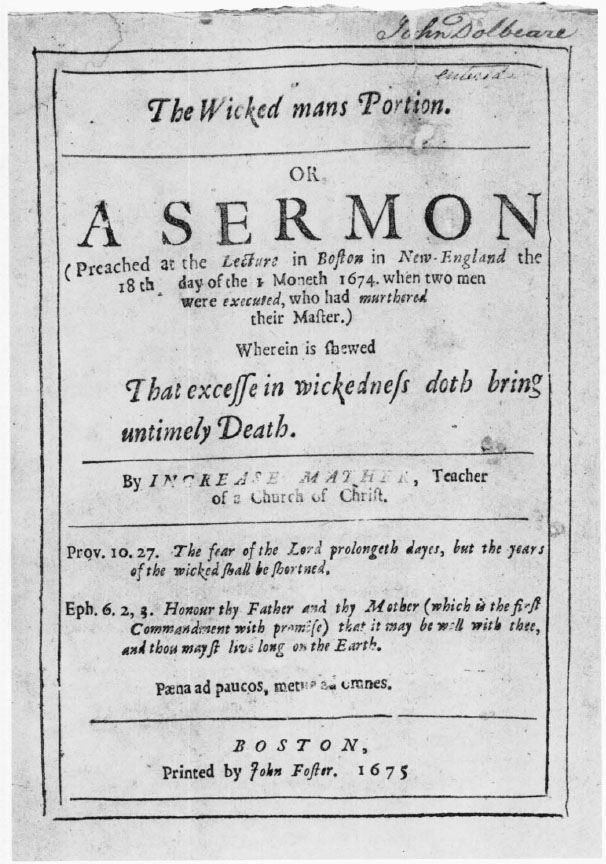
68. Increase Mather’s The Wicked mans Portion. . . , 1675.
American Antiquarian Society, Worcester, Massachusetts
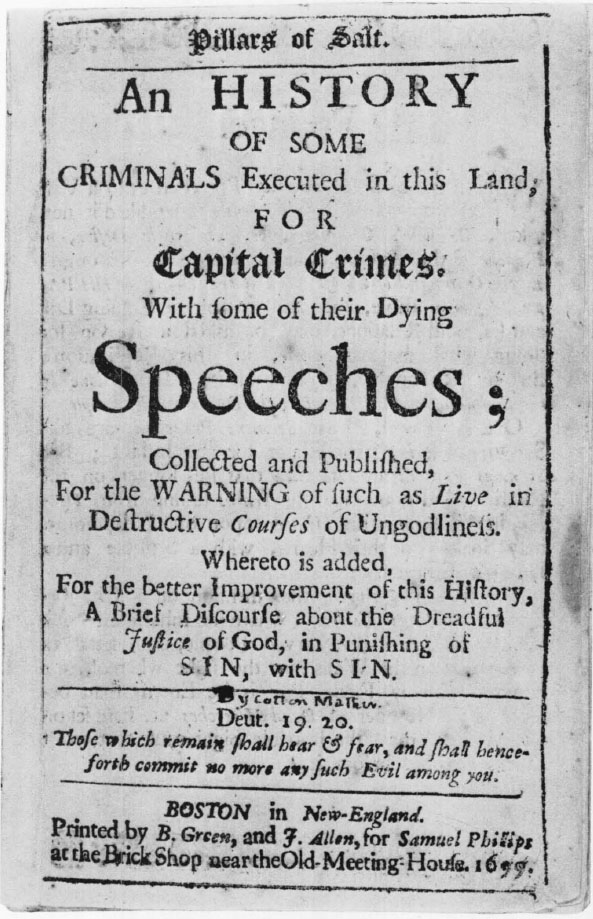
69. Cotton Mather’s Pillars of Salt. . . , 1699.
American Antiquarian Society, Worcester, Massachusetts
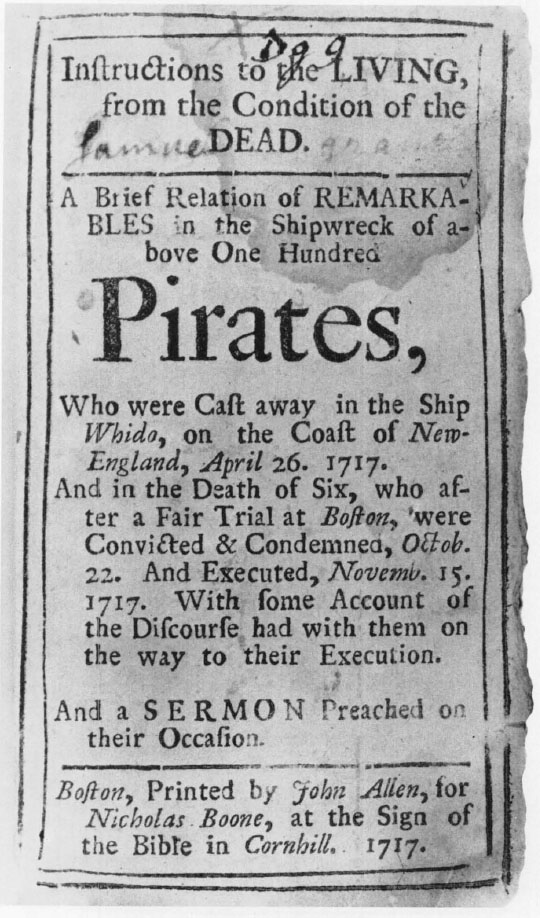
71. A Brief Relation of Rernarkables in the Shipwreck of above One Hundred Pirates . . . , 1717.
Massachusetts Historical Society, Boston
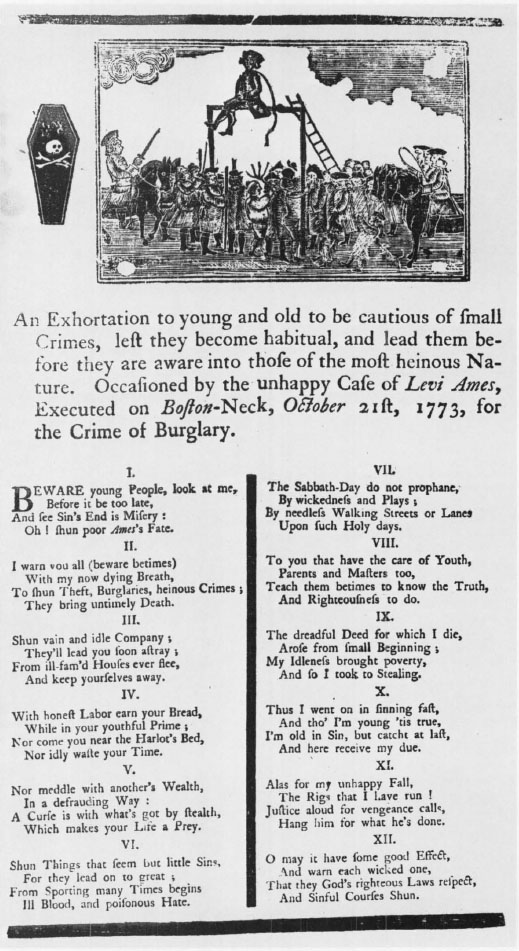
75. “An Exhortation to young and old to be cautious of small Crimes. . . ,” broadside, 1773.
The Historical Society of Pennsylvania
Thus, in 1648, the Massachusetts General Court favored confession in the case of one John Dand. What his crime was does not appear, but in answer to his petition for forgiveness, the court said: It was “meete (on his acknowledgment hereto annexed . . .) that he should be freed from his imprisonment, & his fine is readily remitted him, to manifest the Courts ready inclination to shew all due incuragment to delinquents to confes their errors, and acknowledg the justice of the Courts proceedings, rather than put any to such temptation as should either dishonor God or wound their owne consciences, by hardening them selves in their evill courses.”8
The most famous series of court confessions in colonial New England, of course, was that connected with the witchcraft cases in Salem Village in 1691 and 1692. Here, according to Charles W. Upham, some fiftyfive persons declared themselves guilty of having made pacts with the devil in order to become witches.9 One obvious reason that so many confessed was that it was the only sure way to escape the scaffold. It was confess or die, and they knew it. Yet some there were, undoubtedly, who believed what they confessed. Esther Forbes, in her A MIRROR FOR WITCHES, has persuasively demonstrated this in her imaginative reconstruction of the spirit of the time.1
With private diaries, church meetings, and court sessions rich in the act of confession, it would have been astonishing had no published literature appeared focusing on this act of contrition.
III
The first True Confession and Dying Warning published in New England was Increase Mather’s execution sermon for two men who had murdered their master in 1674, a quarter of a century before the genre reached its classic expression. Entitled The Wicked mans Portion, this publication has many of the elements of John Rogers’ later and longer work, but only in rudimentary form.2 Mather had visited the condemned men in jail, elicited partial confessions from them, and expressed some hope for their salvation: “The Blood of Christ [he said] can satisfie for the blood which you have shed. Jesus doth deliver from wrath to come. And he doth not exclude you from salvation by him, if you doe not by Impenitency & Unbelief exclude your selves.” But, warned Mather, the criminals had not yet completely confessed, for they “accuse and impeach one another” of the deed itself.3 Only with complete confession and true penitence would Jesus save.
Taking his text from Ecclesiastes 7:17, “Be not overmuch wicked, neither be thou foolish: why shouldest thou dye before thy time,” Mather canvassed the field of wickedness using the condemned malefactors as horrid examples. He was particularly concerned with the sin of disobedience. Magistrates and ministers were not honored, schoolmasters were despised and disobeyed, and, he said, “Look into Families, and O what disobedient Children? O what unruly servants may we find there? . . . If there be any prevailing iniquity in New-England this is it. And therefore no marvell that such an awfull Providence doth come to rebuke and humble us, that servants have conspired together to Kill their Master. . . . And mark what I say, If ever New-England be destroyed, this very sin of disobedience to the fifth Commandment will be the ruine of this Land.”4
Between Increase Mather’s first published example (which went to two editions)5 and the classic example by John Rogers twenty-five years later, a dozen True Confessions and Dying Warnings were published in New England. Only three, however, add new literary elements that are fully developed in Rogers’ book in 1701. These appear in three accounts about the same man, one James Morgan.
The first occurs in Increase Mather’s A Sermon, Occasioned, by the Execution of a Man found Guilty of Murder. . . . Published in Boston in 1686, this work was much more elaborate than Mather’s initial book in the genre. It includes sermons by three ministers, all uttered the day of execution, and the complete confession of the condemned Morgan as allegedly taken down in shorthand.
The next year a second edition appeared, to which had been added the second new element—a discourse between the prisoner and a minister. It was prefaced by a note from the printer to the reader: “The general Usefulness & Acceptableness of this Book, together with the speedy sale of the 1st Impression, as also some gain to my self & good to others, has enclined me to renew the Impression. . . .”6 The printer went on to point out that he had added the new element on his own.
In this obvious attempt to introduce a note of realism, the condemned Morgan overheard a man mocking him when he stumbled: “I have mocked & scoffed like that man,” he said, “and see what it hath brought me to: he may come to the like.” Next, poor Morgan sighted the scaffold: “Oh what a huge Multitude of people is come together on this occasion!” he exclaimed. Finally, they reached a “miery way.” Said the minister: “I’m sorry so small a thing as a plashy Street should make me lose one minute of this more-than-ordinary precious time. . . .”7
The third new literary element is a verbatim report of the Dying Warning. This first appears in Cotton Mather’s Pillars of Salt. An HISTORY OF SOME CRIMINALS Executed in this Land; for Capital Crimes. With some of their Dying Speeches; Collected and Published, For the WARNING of such as Live in Destructive Courses of Ungodliness. . . (Boston, 1699). It was subsequently reprinted in his Magnalia Christi Americana.
The first fifty-eight pages of Pillars of Salt are devoted to an analysis of the way God punishes sin with sin, based on an account of “a Young Woman, but an Old Sinner” hanged for the murder of her baseborn child.8 Towards the end of this section Mather generalizes on the kinds of sin that led most of the malefactors to their deaths: “Apostasy from Good Beginnings in Religion. . . Notorious Unprofitableness under the Means of Grace. . . Evil Company Keeping . . . and Disobedience to Parents.” The latter, a violation of the Fifth Commandment, was the sin most frequently lamented, and in these words: “Oh my disobedience to my Parents, my Disobedience to my Parents, and my Ungovernableness, under such Parents and Masters, as God had given me.”9
The last fifty pages or so of Pillars of Salt are given over to accounts of thirteen hangings for adultery, sodomy, and murder. In the midst lies the case of poor James Morgan, now with the full paraphernalia of the True Confession and Dying Warning—the sermon, the discourse between the minister and the condemned, the confession, and the “verbatim” dying warning. As Morgan ascended the gallows, said Mather, his last words, hitherto unreported, had been recorded in shorthand. They are a not-unexpected catalogue of sins to avoid—swearing, drinking, whoring, evil-company-keeping, sabbath-breaking, and murder. “O take warning by me,” Morgan concluded, “and beg God to keep you from this sin which has been my ruine.”1
With the publication of Cotton Mather’s work in 1699, John Rogers had available to him all the elements for emulation and elaboration in his book about poor Esther Rodgers to be published in 1701. Thereafter, down to the Revolution, no new elements were added, although the total works in this genre reach over one hundred. They vary in the numbers of sermons included, and thus in length, but the basic pattern remains the same, either complete with all the elements or published in attenuated form. Some were published as broadsides, with woodcuts, and no doubt achieved wide circulation. Further changes are to be found on somewhat subtler levels such as the origins of the confessors themselves and the meanings of the confessions they uttered.2
IV
At an average of little more than one a year from 1674, published True Confessions and Dying Warnings hardly constitute a major literary contribution, even without reference to their literary quality. But if they did not shape the past, they at least provide a clue to it and therefore provoke curiosity.
Initially, at least, one can accept this literature at face value, particularly in view of the historical record regarding confessions in private, in church, and in court. The New Englanders did commit crimes, and for one reason or another, they were led to contrition. This fits well with the Puritans’ view of themselves. Wrote Samuel Willard of Boston’s South Church: a new life discovers itself “By a free and hearty Confession of . . . Sin. And this, though not always to Men, in regard of some particular Sins; yet always to God, whose Law is broken. . . . This is always a proper adjunct of true repentance and it waits upon it; so that he who upon Conviction of Sin, doth not freely Confess it to God . . . , hath sufficient reason to fear that he never repented of it. The very burden which his Conscience is distressed with, by reason of it, will make him to seek relief. . . .”3 Undoubtedly it was partly the importance which Puritan thought placed on the role of confession in achieving a restored conscience and ultimate salvation that led to its emphasis in the private lives and the public literature of the time.4
Even at face value, True Confessions and Dying Warnings raise a question, although they do not provide an answer, about Puritan ideas versus Puritan practice. How could Puritans who believed strongly in predestination—a belief that no act of a man can affect his salvation—reconcile that belief with the necessity of holding out some hope for salvation so that man would try to live according to God’s law? The ministers had worked out a very sophisticated covenant theory that barely fell within the doctrine of predestination. But in actual practice, when confronted by a simple layman, they taught, I suspect, a doctrine dangerously close to “good works.” It was necessary that men be good, or at least that they act as though they were good, in spite of themselves. As the late Perry Miller put it: the elect “are covenanted to sainthood, not forced into it, and they are to be saved for trying, not for succeeding, whereas the reprobate are eternally damned, not for failing, but for not trying.”5
Thus in parish work as distinguished from scholarly debate, the Puritan minister possibly placed less emphasis on election as an arbitrary act of God, than upon the individual sinner’s seeking God through repentance and confession. As we have seen in the case of Esther Rodgers, the ministers were almost, if not quite, persuaded of her chances for salvation. Later, in an execution sermon delivered in 1721, while admitting that God’s grace is necessary for salvation, Cotton Mather argued that a serious and sincere repentance, a seeking for God’s grace, creates a hope, a sign, that God will grant it.6 Did his listeners go one step further and see cause and effect?
The Reverend William Cooper’s preface to an execution sermon by Thomas Foxcroft in 1733 does take that step. “It may be,” he wrote, that “there is no Place in the World, where such Pains are taken with condemned Criminals to prepare them for their Death; that in the Destruction of the Flesh, the Spirit may be saved in the Day of the Lord Jesus.” Time, he said, sometimes a month, is always given by “compassionate Judges” so that the prisoner might achieve salvation.7 Thus, the sermons not only warned that the gallows lay at the end of evil behavior, but also that damnation lay on the other side of the gallows. By inference, good behavior, or true repentance for bad, would result in escaping the gallows and, perhaps, in achieving salvation as well.
But acceptance at face value—even with presumptive salvation thrown in—does not totally satisfy as an explanation of the meaning of True Confessions and Dying Warnings. It is only the outer and most obvious layer. To go beyond one needs only to ask why they were published at all once the confessors and dying warners were dead.
The obvious answer is that the genre was a form of hortatory literature consciously designed to make the criminal acts detestable and to induce proper behavior in society as a whole. And since most of the listeners to the sermons and readers of the True Confessions and Dying Warnings were not criminals, but rather, at worst, doers of minor evils, it was necessary to trace the criminal career back to its origins and to generalize about the nature of crime itself. Then one’s auditors and readers could see where their small peccadillos were leading them. Mighty oaks of crime from little acorns of disobedience would grow. Death and damnation would be the results.
Almost invariably the root cause of wickedness was found in a breaking of the Fifth Commandment—“Honor thy father and mother—that thy days may be long in the land which the Lord thy God giveth thee”—usually as disobedience to parent or master. Occasionally the miscreant’s life of crime is traced back to an early theft, or, later in the eighteenth century, to drink, but throughout the period the Fifth Commandment is invoked with regularity. This may indeed be significant, for it is under this Commandment that Samuel Willard, for example, organized his entire analysis of society: the relationships between parents and children, husbands and wives, masters and servants, magistrates and people, rulers and subjects, and ministers and flock. Without obedience to the Fifth Commandment, order would disappear and society would collapse.8
Rather than being only, or even primarily, verbalized acts of individual religious piety, then, True Confessions and Dying Warnings were also social acts consciously designed as a necessary cement to hold society together. This was particularly true in the period of their emergence as a New England literature, 1674–1701. Whether or not one accepts Perry Miller’s idea and timing of Puritan declension, these years saw some awesome events in the transition from the God-oriented community of Winthrop’s “Modell of Christian Charity” to a secular and commercial society. I doubt that it was pure coincidence that the emergence of confession literature occurred during the period of King Philip’s devastating war and subsequent Indian troubles, the loss of the Massachusetts Charter, the imposition of royal control under the new charter, the introduction of the Anglican church into Boston, the witchcraft trials of the 1680s, and the progressive decline of the influence of the clergy.9
In the midst of Cotton Mather’s greatest Jeremiad of them all, the Magnalia Christi Americana (1702), lies his explanation for publishing Pillars of Salt in 1699: “One of the New-English ministers, [he wrote, referring to himself, characteristically in the third person] beholding vice besieging his country as an enemy, singled out a company of dead wretches to set upon the walls, in hopes that the horrible sight would cause that worst enemy to fly before it.”1 Here was a row of antiheroes, negative symbols for the godly community.
The social utility of, and even necessity for, confessions is underscored by the apparent lengths society went to to get them. We have seen that Esther Rodgers was visited by several ministers, that Increase Mather rebuked the two murderers of their master for incomplete confession, and that James Morgan’s True Confession and Dying Warning grew in size and complexity over three editions published over a period of twenty years. That Morgan’s words may have been put into his mouth, is suggested by Robert Calef’s admittedly hostile account of the witchcraft trials.
Wrote Calef: “besides the powerful Argument of Life (and freedom from hardships and Irons not only promised, but also performed to all that owned their guilt), There are numerous Instances . . . of the tedious Examinations before private persons, many hours together; they all that time urging them to Confess (and taking turns to persuade them) till the accused were wearied out by being forced to stand so long, or for want of Sleep, etc., and so brought to give Assent to what they said; they then asking them, ‘Were you at such a Witch meeting,’ or ‘have you signed the Devil’s Book?’ etc. upon their replying ‘yes,’ the whole was drawn into form as their Confession.”2
It is doubtful that the New-England malefactors were aware of the implications of their confessions, doubtful even that society was fully aware of them. Yet, it is evident that for reasons of state as well as soul the Puritans had a need to exact confession and acceptance of the meteness of the punishment from those who had violated the mores of the community. This was especially so in the time of crisis. In admitting their guilt, in giving detailed accounts of it, and in admitting the justice of the sentences imposed upon them, New England’s confessors and dying warners acquiesced in the laws they had broken, and they reinforced the role of society in exacting conformity.
The case of Hugh Stone, convicted of murdering his pregnant wife, is instructive in this regard. In the course of several visits by a minister, Stone finally admitted that his sins were so abominable that, even were he to be pardoned by the court, he would insist that the sentence be carried out. He agreed that by breaking one commandment he had literally broken them all, not in the figurative sense that Saint James used, but literally. Society was just in executing him for his crime.3
Thus by confessing, and consenting, the early True Confessors found social as well as spiritual salvation. It was the final act of exercising the liberty of which John Winthrop had spoken, the liberty to obey God’s law by “subjection to authority.”4
If the True Confessions and Dying Warnings were at least partially symbolic as well as historic in the early period, and if they held a social meaning as well as a private meaning, did the phenomena persist down to the Revolution? The answer is a complicated and qualified yes. It is complicated and qualified by two significant changes in the literature.
First, there was a remarkable change in the cultural and social origins of the confessors themselves. While in the seventeenth and early eighteenth centuries the confession-seeking minister would find himself walking down a “plashy” way with a wayward member from within the society, in the eighteenth century he was more than likely to accompany a black, an Indian, an Irishman, or a foreign pirate. Just as most illegal protests in the servant class then arose from the blacks, whom Samuel Sewall described as being of “extravasat blood” who can “never embody with us,” from the “Verminous Irish,” as James Franklin’s Courant called them, or from other outsiders,5 so among the hanged confessors, the majority then came from outside the community. Internal deviants to pray with, and for, were replaced by external enemies to be rid of.6
This change in personae explains, or at least leads to, the second change in the eighteenth century. Earlier, the self-doubting Puritan knew, as he watched the dying throes of a condemned malefactor, that very little separated himself from the almost sacrificial victim on the gallows. He too had started sinning with disobedience and might not stop in time. Had not his neighbor, there on the gallows? But in the eighteenth century, the victim was often outside his ken, and the literature as well as the event, while still instructive, could become primarily diverting, even entertaining.
Thus, the tone of True Confessions and Dying Warnings seems gradually to change from one of moral suasion to an increasingly popular one of titillation. New editions designed to capitalize on a readers’ market were issued. Rival works were published dealing with a particular malefactor. And, in at least one instance, a condemned prisoner repudiated one confession attributed to him and issued an “authorized” confession with another printer.7
This exploitation of the genre reached the point where in 1773 eleven separate publications were issued dealing with one condemned prisoner, Levi Ames, executed for burglary. Most were not, however, sermons, and conversations, and confessions published in pamphlet form; instead, they were broadsides.8
It is the change to broadside publication, in fact, that is the most significant alteration in form for True Confessions and Dying Warnings in the eighteenth century. With that change came the introduction of woodcuts, usually with the gallows prominently featured, and the use of verse. When, for example, an Indian named Julian was hanged for murder, three broadsides were issued:
The last SPEECH and dying ADVICE of poor Julian. . . (Boston, [1733]).
Poor Julleyoun’s Warnings To Children and Servants To shun the Ways of Sin. . . (Boston, [1733]).
Advice from the Dead to the Living; OR A Solemn Warning to the World. Occasioned by the untimely Death of poor Julian. . . (Boston, [1733]).
Two of these broadsides came from the same printer, two were in verse, each has a different woodcut: a death’s head, a cut of the hanging, and a representation of the murder itself. One warning from poor Julian ends as follows:
And now Farewell my dearest Friends,
For times with me have now its ends,
Until the last great Trump shall sound
When Rising from the lonesome Ground,
In Jesus I do Hope to Rise,
In Peace and Joy to my Surprise.9
Finally, the sub-genre had become so secularized by popularization and the use of burlesque-like broadsides that the form could be borrowed in 1750 not to illuminate the sins of man, the necessity of confession, the hope of salvation, or the terrors of damnation, but rather to express the desire for a more stable currency! In that year, two broadsides lamented the passing of the paper currency known as Old Tenor. One, entitled The Dying Speech of Old Tenor, on the 31st of March 1750; being the Day Appointed for his Execution, ends with these lines:
Altho’ this Day looks dark, and Hearts are sad,
Mind not the Frowns of wicked Men who’re glad;
Shortly they’ll say, Old Tenor come again,
But then, Alas! ’twill be too late for them.1
It is symbolic that paper currency had taken the place of—or at least taken a place with—salvation as a central problem of the day, for New England by the mid-eighteenth century had completed the transition from a religious community to an essentially secular society.

